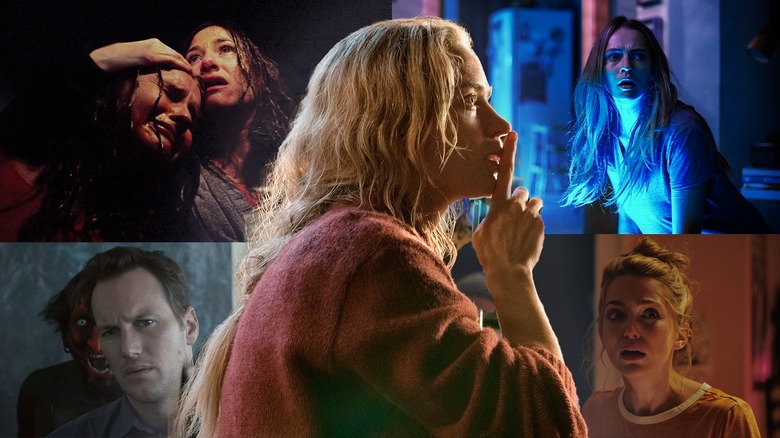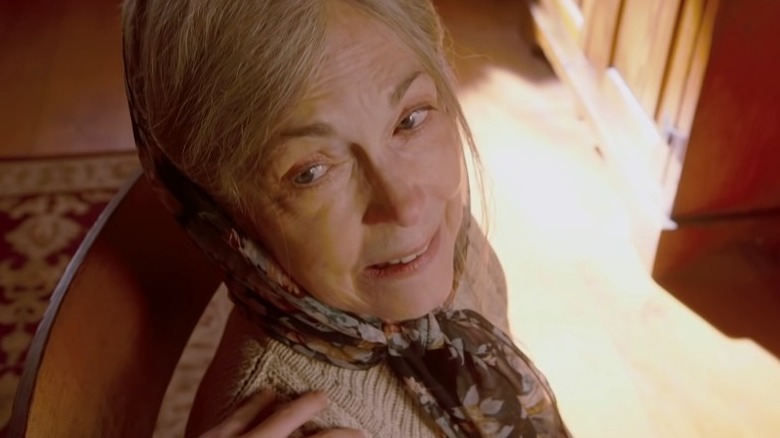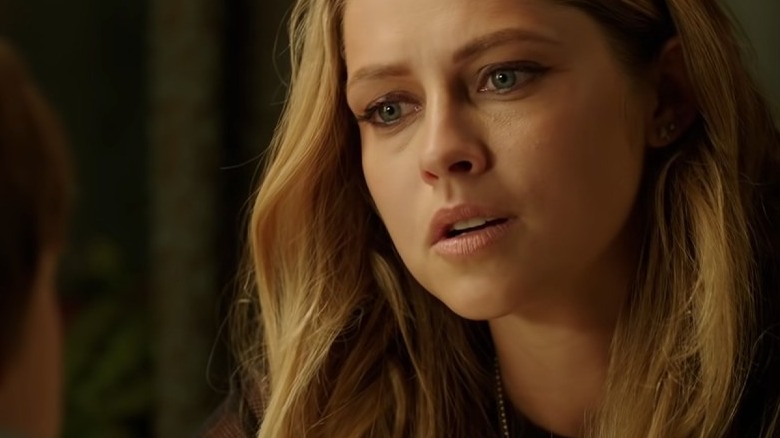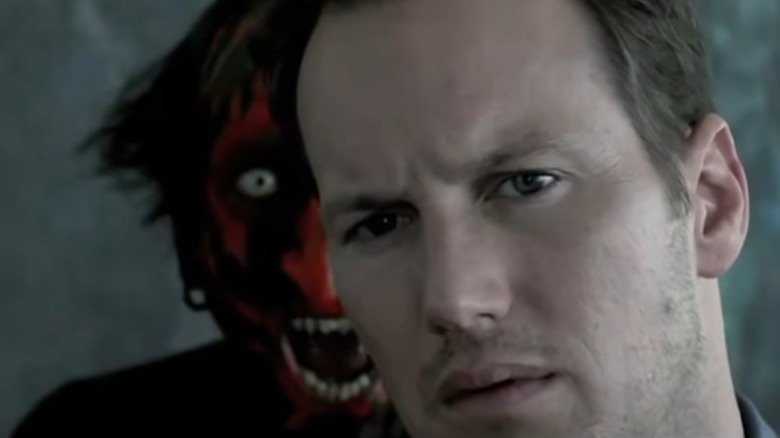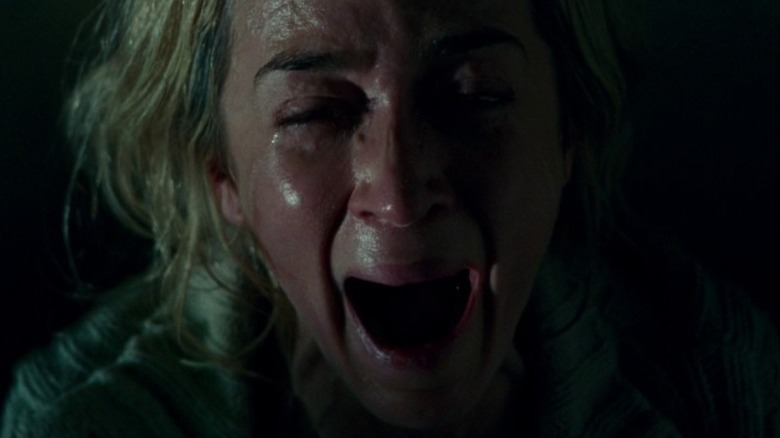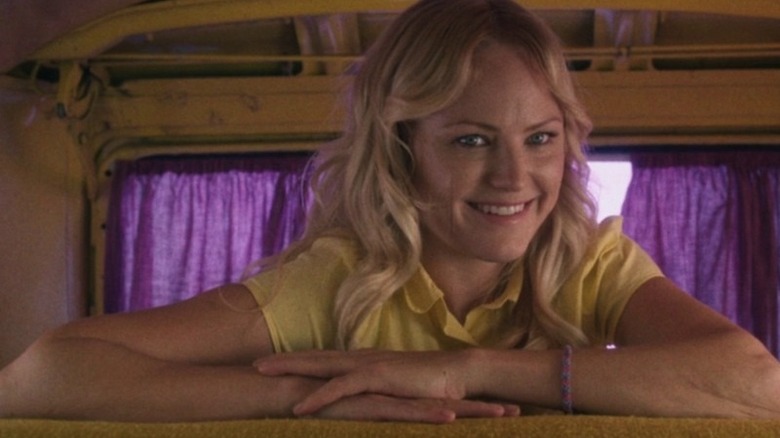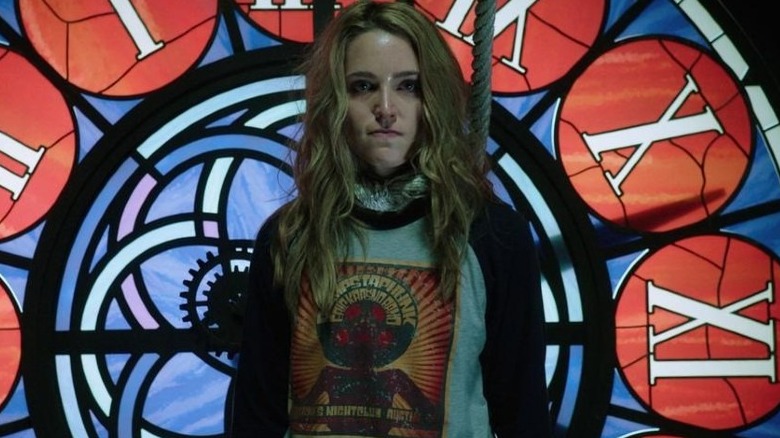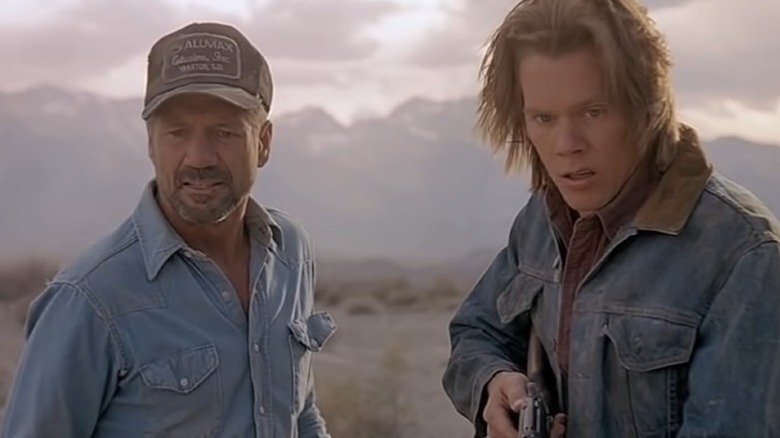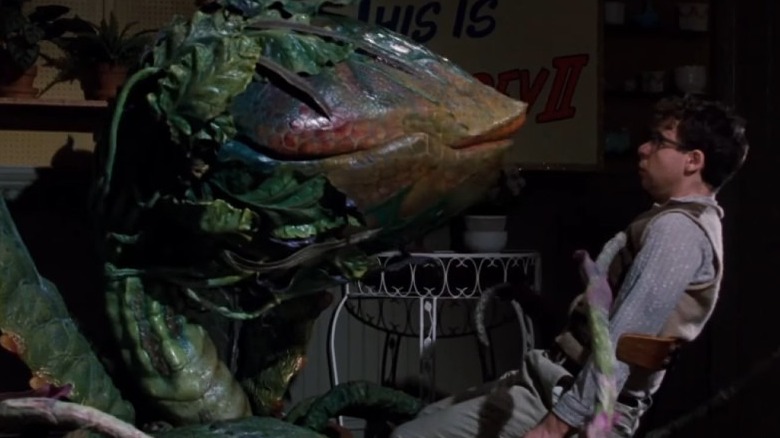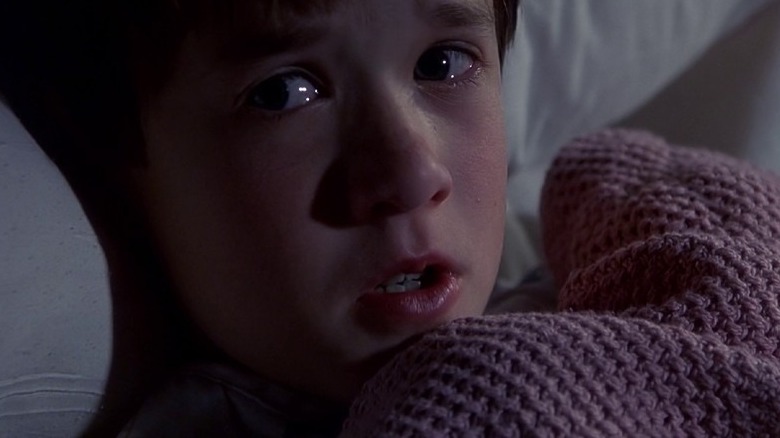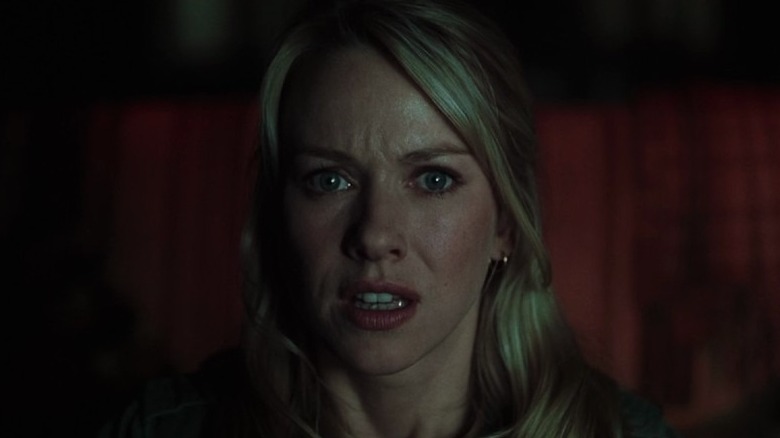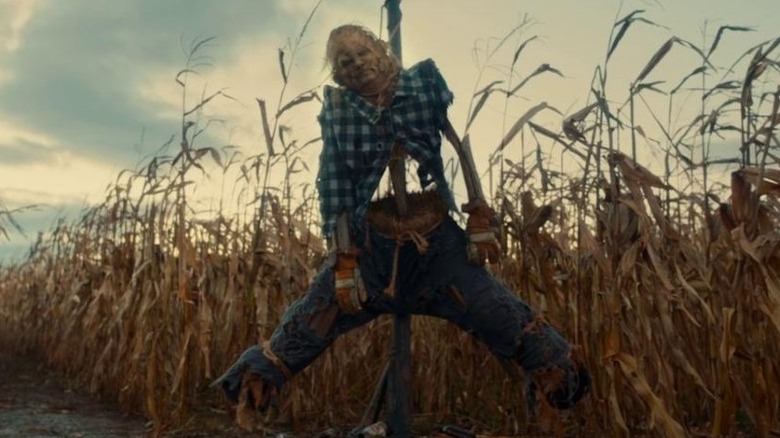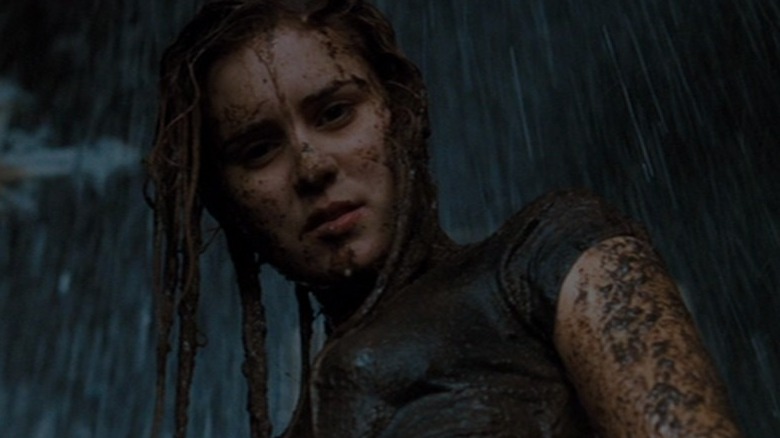12 PG-13 Horror Movies That Prove They Don't Need An R-Rating To Be Great
With the release of "M3GAN," discourse about MPAA ratings has again reared its ugly head. "M3GAN," which scooped in $45 million worldwide during its opening weekend, is rated PG-13. And that has many horror fans deriding the rating, with some arguing that the film suffers from its lack of an R since much of the gore and violence has been tamed for a younger demographic. That's not to say "M3GAN" doesn't have enough bite. It has plenty. As /Film writer Witney Seibold posits, "M3GAN" has enough "nerve" as a PG-13 film. It doesn't need to be rated R.
When it comes to horror, MPAA ratings have never equated quality. Many horror films have been rated PG, including "Poltergeist," for example, that are still just as effective in their storytelling and supply plenty of thrills and chills. It's a tired argument to suggest horror can only excel with an R-rating. Ultimately, the rating doesn't matter. It's simply a barometer for parents to gauge a film's content and their child's ability to see it. Nothing more.
To put the issue to bed, we've compiled a list of PG-13 horror movies that are just as terrifying as any R-rated ones. There are singing plants from outer space, demons, masked serial killers, and a few ghost stories. The frights you so desire are on this list. So sit back and let the conversation die down. It's all just noise. Regardless of what people say, PG-13 horror flippin' rules.
The Visit
The official poster for the found footage chiller "The Visit" presents it as a twisted fairy tale. You wouldn't be wrong in thinking this. "The Visit" is far more than just twisted. It's downright disturbing. When two siblings, Becca (Olivia DeJonge) and Tyler (Ed Oxenbould), visit their grandparents, they grow increasingly concerned about their strange behavior. For instance, late at night, Nana (Deanna Dunagan) claws at the walls.
Writer-director M. Night Shyamalan rearranges genre expectations in his style, tacking on a twist ending (as he usually does). Throughout the film, there's very little, if any, blood or gore. Shyamalan relies on the kind of creepiness that soaks into the subconscious. Something always seems off, and it's enough to make your blood run cold. It would have been easy to gun for an R rating. Perhaps the kids end up dead, but it's far from necessary to show their blood splashing across the screen. "The Visit" earns its PG-13 rating without sacrificing genuine scares.
Lights Out
The terror in David F. Sandberg's "Lights Out" emerges in the vein of "The Babadook." Mental health and grief are at the center of the story. A monster lurks in the shadows and follows its victims throughout their daily lives. When they're alone, that's when the fear sets in. "Lights Out" is the story of a young woman named Rebecca (Teresa Palmer) and how she fails to cope with her mother Sophie's (Maria Bello) mental illness. Deep emotional and psychological scars cause Rebecca to pull away from her mother and build insurmountable barriers.
Sophie is plagued by a demon that tells her to do unimaginable things. Consequently, her son, Martin (Gabriel Bateman), must live with Rebecca, who is far from the motherly type. Soon, Rebecca is followed by the same evil entity. As it circles like a vulture closer and closer to them both, Sophie must make a choice. It really is "Sophie's Choice," and it's just as incomprehensible.
"Lights Out" is a testament to great storytelling that explores deep-seated fears. The frights come from the manipulation of the mind. By giving the story a throbbing emotional balance, Sandberg makes you care about the characters and their fates, all while delivering on the real horrors of the world.
Insidious
With a script by Leigh Whannell, "Insidious" takes demonic possession in an exciting new direction. Director James Wan packs devastating punches every step of the way — and not just at that moment when the demon makes its presence known. After their son, Dalton (Ty Simpkins), suffers a fall and slips into a coma, his parents, Josh (Patrick Wilson) and Renai (Rose Byrne), attempt to save him from an unknown entity that plots to suck the life from him in a dream-like realm known only as "The Further." Wan, who also directed "The Conjuring," leans into similar spookiness, and it never suffers from its PG-13 rating.
As things escalate, Josh and Renai decide to move, but the entity follows them. In dire straits, Josh enlists the help of his mother, Lorraine (Barbara Hershey), a psychic named Elise (Lin Shaye), and a pair of paranormal investigators to get to the bottom of things. What transpires is the stuff of nightmares. Through his expert direction, Wan transmits the darkest imagery from the subconscious directly into the viewer's eyes. It truly is a wonder that the MPAA gave this a PG-13 rating. It could have easily been rated R.
A Quiet Place
In "A Quiet Place," Lee Abbott (John Krasinski) and his family must figure out how to survive in an apocalyptic hellscape overrun by aliens that hunt by sound. As the monsters wreak havoc, civilization quickly crumbles. While scavenging for food and supplies, Lee's son, Beau (Cade Woodward), is killed by one of the creatures. Sometime later, the family is still recovering from the tragedy but makes the best of things — considering the state of the planet. With Krasinski also directing, the film offers a compelling creature design, an impactful story, and plenty of tension.
Residing on a secluded farm, the Abbott family must finally confront the beasts that have taken over their lives. To make matters worse, Lee's wife, Evelyn (Emily Blunt), is pregnant. In one of the film's tensest scenes, Evelyn hides in a bathtub and begins giving birth while a creature lurks outside the bathroom door. Fortunately, Lee notices the red lights used as an emergency signal and sets off fireworks as a distraction. It's storytelling at its most masterful.
That's the thing about "A Quiet Place." It doesn't need gore or blood to create a perfectly frightening atmosphere. Its exploration of family life in a post-apocalyptic world is enough.
The Final Girls
"The Final Girls" has very little blood and mostly implied violence, but that doesn't make it any less effective. Directed by Todd Strauss-Schulson, the slasher dissects grief and how movies can help people recover from pain. Strauss-Schulson slathers bright colors on the screen and entices the viewer into a heightened world featuring a film within a film. As Max (Taissa Farmiga) attempts to cope with her mother Amanda's (Malin Åkerman) untimely demise, she decides to attend a late-night screening of the '80s cult classic "Camp Bloodbath," which starred her mother as a character named Nancy. When the film reaches Nancy's death scene, Max flees as the theater erupts in flames. Max and her friends bolt to an exit behind the silver screen and are instantly transported into the movie.
The group must figure out a way to escape the film while also dodging the sharp blade of Billy Murphy (Daniel Norris), a monstrous creature in the tradition of Jason Voorhees. True to the slasher genre, the characters are slowly picked off. Even without much gore, it's still a highly thrilling film, with inventive camera work and a strong emotional center.
"The Final Girls" succeeds based purely on its heart. The cast takes the material seriously but also makes it campy and fun. Explicit blood and guts would have detracted from what makes "The Final Girl" so darn special.
Happy Death Day
In "Happy Death Day," Theresa "Tree" Gelbman (Jessica Rothe) is a popular girl with an abrasive personality. Taking a cue from "Groundhog Day," the film follows Tree as she's forced to relive her birthday and her subsequent death. Someone wearing a creepy baby mask is out to kill her, and to break the cycle, she must solve the mystery before time runs out.
Tree's not a good person, an epiphany she has well into the film. Time and again, she sees her life flash before her eyes. Consequently, she comes to appreciate what she has. However, each death causes real damage to her body, and she grows increasingly weaker. Tree enlists the help of her classmate Carter (Israel Broussard) to crack the case. It takes some time, but she eventually discovers the person behind the mask.
As with "The Final Girls," "Happy Death Day" contains minimal blood. Its success stems from graphic depictions of violence that don't rely on assaulting the senses. The fight sequences or when Tree dies over and over again could potentially have been gory, but excessive blood was wholly unnecessary. The film's charm lies in its story and how it diverges from what we expect from a slasher film. Director Christopher Landon weaves genres and tropes to give "Happy Death Day" a unique vision. It's tense, thrilling, campy, and keeps you glued to the screen. It doesn't need anything else.
Tremors
A gnarly creature design more than makes up for the lack of blood in "Tremors." In Ron Underwood's 1990 film, a group of survivors in the small town of Perfection, Nevada, come under attack from wormlike monsters. Dubbed "Graboids," they slither beneath the ground, using sound to hunt their prey. And much like the Xenomorphs of the "Alien" franchise, the creatures' mouths contain appendages that lurch from their jaws to devour animals and humans alike.
Led by Val (Kevin Bacon) and Earl (Fred Ward), the residents of the sleepy little town soon learn that to survive, they either have to make it to the mountains and safety or figure out a way to kill the subterranean beasts. With the help of geology student Rhonda (Finn Carter) and doomsday prepper Burt (Michael Gross) and his wife, Heather (Reba McEntire), the group bands together and uses dynamite to blow the creatures to smithereens. "Blood" only appears when a Graboid is obliterated in a shower of entrails. Underwood uses gore effectively and never overdoes it.
Little Shop of Horrors
Released in 1986, "Little Shop of Horrors is based on Howard Ashman and Alan Menken's 1982 stage musical, itself an adaptation of Roger Corman's notorious 1960 horror quickie. Meek and mild Seymour (Rick Moranis) buys a strange plant that appears during a solar eclipse and brings it to the Skid Row flower shop where he works for Mr. Mushnik (Vincent Gardenia). Seymour places the new plant, which he names Audrey II for his squeaky-voiced co-worker and crush (Ellen Greene), in the window, and it attracts big business.
What Seymour doesn't account for is the plant's thirst for blood. He initially allows the plant to suck on his bleeding finger, but it quickly becomes evident Seymour must feed it animals and, possibly, human beings. So begins Seymour's murder spree. The first to die is Audrey's abusive boyfriend, the sadistic dentist Orin Scrivello (Steve Martin). Even Mr. Mushnik falls victim to Audrey II. As revealed in the finale, Audrey II is plotting to take over the planet. Fortunately for humanity, Seymour comes to his senses and refuses an offer from Patrick Martin (Jim Belushi) of World Botanical Enterprises to market Audrey IIs to the public and decides the evil plant must be destroyed.
When you have a musical as great as "Little Shop of Horrors," there's no need for blood and gore. The musical numbers, character dynamics, and the story itself are thrilling enough. Audrey II is such an inspired creation that graphic violence would only distract. It's perfect as is.
The Sixth Sense
"The Sixth Sense" is a classic ghost story. Cole (Haley Joel Osment) can see dead people, and his mother, Lynn (Toni Collette), struggles to communicate with him. Cole holds onto his dark secret until therapist Malcolm Crowe (Bruce Willis) makes a breakthrough in one of their sessions. Cole explains, "They don't see each other. They only see what they want to see. They don't know they're dead." Hands down, it's the film's most iconic piece of dialogue. Except for a few scenes, the film is bloodless. The scares emerge from the film's atmosphere. Someone — or something — is always lurking in the shadows.
"The Sixth Sense" effectively gets to the core of universal terror. Through a grounded human story, director M. Night Shyamalan impresses upon audiences that the best frights come from authentic storytelling. It's not about jump scares (although there are a few) but the terrors that creep up on you. "The Sixth Sense" is an enthralling tale of grief, fear, and how death can linger. Blood and guts would have derailed this tightly wound story.
The Ring
A videotape that kills those who view it in seven days is the basic setup of 2002's "The Ring," an American remake of the 1988 Japanese film "Ringu," based on Koji Suzuki's 1991 novel of the same name. After her niece Katie (Amber Tamblyn) dies under mysterious circumstances, Rachel (Naomi Watts) makes it her mission to uncover the truth behind the videotape and its origins. She begins by dissecting the videotape's imagery, from the creepy mirror shot to an image of a lighthouse. Eventually, she finds her way to a farmhouse on Moesko Island.
Director Gore Verbinski keeps the fear tucked away in spooky, blood-curdling imagery. The story is a slow burn, yet the images he uses are an assault on the senses. Throughout the film, Rachel draws closer and closer to uncovering the truth but faces her mortality. Each day that passes puts her more firmly in young Samara's (Daveigh Chase) gnarled, water-logged grip. "The Ring" is one of those remakes that more than lives up to the original. Blood? Who needs it? It's a terrifying chiller all on its own.
Scary Stories to Tell in the Dark
If you grew up in the '80s and '90s, you no doubt still have nightmares about Alvin Schwartz's book series, "Scary Stories to Tell in the Dark." Mostly, the bone-chilling illustrations struck fear in our collective hearts. You probably remember Harold the Scarecrow, the Pale Lady, and the girl with the spider bite. In the 2019 film version directed by André Øvredal, those images find horrifying new life in visual depictions that seem ripped from those haunting pages. The creatures will make you shiver with genuine terror.
After discovering accused witch Sarah Bellows' (Kathleen Pollard) cursed notebook, Stella (Zoe Colletti) notices stories appearing on their own on blank pages. First, Harold appears in a nearby cornfield, igniting a trail of fear and mayhem. Later, other stories come to life, including "The Big Toe," "The Dream," "The Red Spot," and "What Do You Come For?" Stella and her friends are forced to confront each of these monsters and find a way to give Sarah Bellows peace in the afterlife.
"Scary Stories to Tell in the Dark" is an undeniably faithful adaptation that also explores its own terrifying story through Stella's eyes. It might be rated PG-13, but it's gripping and dark in all the right spots. Now, we wait for a sequel with bated breath.
Drag Me to Hell
All hell breaks loose in writer-director Sam Raimi's "Drag Me to Hell." Alison Lohman plays Christine Brown, a loan officer gunning for a promotion. To prove herself to her boss, Christine decides not to extend an elderly woman's mortgage. Later, the woman rips a button from Christine's coat and places a curse on her. In three days, she'll pay a heavy price, but her torment begins almost immediately. A violent entity follows her and attacks her when she's alone.
Fortune teller Jas (Dileep Rao) tells her that a blood sacrifice may appease the demon. It's all for naught, however. The evil spirit can't be sated so easily, and it continues torturing her. As long as Christine possesses the button, there's no doubt about her inevitable fate. She must rid herself of the curse by giving the button to someone else, but her conscience gets in the way. She can't do it. Ultimately, her fate is sealed.
Raimi knows what he's doing when it comes to horror storytelling. Tension and mood are as vital to the story as the characters. Even without an R-rating, its ghastly imagery is relentless. It's good old fashion fun.
